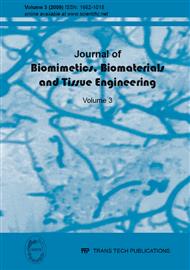p.1
p.25
p.37
p.51
p.59
p.93
Finite Element Analysis of the Membrane Used in a Novel BioMEMS
Abstract:
With new applications in the area of diagnostics, drug discovery and genetics, the need for Biological Micro-Electro-Mechanical Systems (BioMEMS) has increased tremendously in the last decade. Especially, surface stress-based BioMEMS has been investigated extensively in the recently years. In this paper, a new BioMEMS is proposed, which can be used to detect cells. It consists of microfluidics, square membrane and a fiber optic interferometer. The square membrane as the crucial and sensitive part includes three layers, self-assembled monolayer (SAM), gold and substrate material. Based on the BioMEMS, some fundamental study has been done, especially for the membrane due to its crucial role in the whole system. The finite element (FE) method has been used to study the membrane with different substrates. By the fundamental study, some important conclusions have been acquired: (1) The square membrane will reach maximal deflection at different ratio values (P: membrane size) to different substrates; (2) To a certain substrate, such as PDMS, the ratio making the membrane reach maximal deflection is different to dissimilar PDMS layer thickness; (3) If young’s modulus (E) of the substrate is too small, separation may happen between the gold layer and substrate layer when the gold size becomes smaller.
Info:
Periodical:
Pages:
51-57
Citation:
Online since:
July 2009
Authors:
Keywords:
Price:
Сopyright:
© 2009 Trans Tech Publications Ltd. All Rights Reserved
Share:
Citation:


